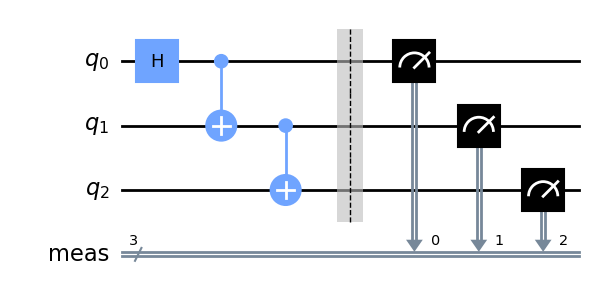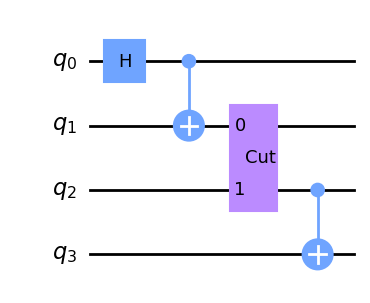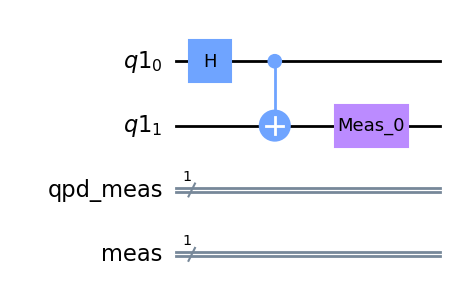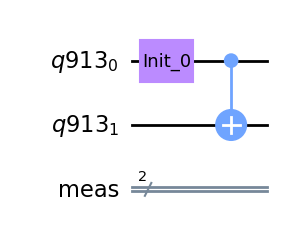Usage#
QCut is a quantum circuit knitting package for performing wire cuts especially designed to not use reset gates or mid-circuit since on early NISQ devices they pose significant errors, if they are even available.
QCut has been designed to work with IQM’s qpus, and therefore on the Finnish Quantum Computing Infrastructure (FiQCI), and tested with an IQM Adonis 5-qubit qpu. Additionally, QCut is built to be combatible with IQM’s Qiskit fork iqm_qiskit.
QCut was built as a part of a summer internship at CSC - IT Center for Science (Finnish IT Center for Science).
Installation#
pippip install QCut
Using pip is the recommended install method.
Basic usage#
1: Import needed packages
import QCut as ck
from QCut import cut
from qiskit import QuantumCircuit
from qiskit_aer import AerSimulator
from qiskit_aer.primitives import Estimator
2: Start by defining a QuantumCircuit just like in Qiskit
circuit = QuantumCircuit(3)
circuit.h(0)
circuit.cx(0,1)
circuit.cx(1,2)
circuit.measure_all()
circuit.draw("mpl")

3: Insert cut_wire operations to the circuit to denote where we want to cut the circuit
Note that here we don’t insert any measurements. Measurements will be automatically handled by QCut.
cut_circuit = QuantumCircuit(3)
cut_circuit.h(0)
cut_circuit.cx(0,1)
cut_circuit.append(cut, [1])
cut_circuit.cx(1,2)
cut_circuit.draw("mpl")

4. Extract cut locations from cut_circuit and split it into independent subcircuit.
cut_locations, subcircuits, map_qubit = ck.get_locations_and_subcircuits(cut_circuit)
Now we can draw our subcircuits.
subcircuits[0].draw("mpl")

subcircuits[1].draw("mpl")

5: Generate experiment circuits by inserting operations from a quasi-probability distribution for the identity channel
experiment_circuits, coefficients, id_meas = ck.get_experiment_circuits(subcircuits, cut_locations)
6: Run the experiment circuits
Here we are using the qisit AerSimulator as our backend but since QCut
is backend independent you can choose whatever backend you want as long
as you transpile the experiment circuits accordingly. QCut provides a
function transpile_experiments() for doing just this.
Since QCut is a circuit knitting package the results are approximations of the actual values.
backend = AerSimulator()
results = ck.run_experiments(experiment_circuits, cut_locations, id_meas, backend=backend)
7. Define observables and calculate expectation values
Observables are Pauli-Z observables and are defined as a list of qubit indices. Multi-qubit observables are defined as a list inside the observable list.
If one wishes to calculate other than Pauli-Z observable expectation values currently this needs to be done by manually modifying the initial circuit to perform the basis transform.
observables = [0,1,2, [0,2]]
expectation_values = ck.estimate_expectation_values(results, coefficients, cut_locations, observables, map_qubit)
8: Finally calculate the exact expectation values and compare them to the results calculated with QCut
paulilist_observables = ck.get_pauli_list(observables, 3)
estimator = Estimator(run_options={"shots": None}, approximation=True)
exact_expvals = (
estimator.run([circuit] * len(paulilist_observables), # noqa: PD011
list(paulilist_observables)).result().values
)
import numpy as np
np.set_printoptions(formatter={"float": lambda x: f"{x:0.6f}"})
print(f"QCut expectation values:{np.array(expectation_values)}")
print(f"Exact expectation values with ideal simulator :{np.array(exact_expvals)}")
QCut circuit knitting expectation values: [0.007532 0.007532 -0.003662 1.010128]
Exact expectation values with ideal simulator :[0.000000 0.000000 0.000000 1.000000]
As we can see QCut is able to accurately reconstruct the expectation values. (Note that since this is a probabilistic method the results vary a bit each run)
Click here to download example notebook.
Basic usage shorthand#
For convenience, it is not necessary to go through each of the
aforementioned steps individually. Instead, QCut provides a function
run() that executes the whole wire-cutting sequence.
The same example can then be run like this:
backend = AerSimulator()
observables = [0,1,2, [0,2]]
estimated_expectation_values = ck.run(cut_circuit, observables, backend)
Running on IQM fake backends#
To use QCut with IQM’s fake backends it is required to install Qiskit IQM. QCut supports version 15.6. Installation can be done with pip:
pip install qiskit-iqm
After installation just import the backend you want to use:
from iqm.qiskit_iqm import IQMFakeAdonis()
backend = IQMFakeAdonis()
To tranpile experiment circuits to the backend one can either manually call qiskit
transpile in a loop or use QCut’s transpile_experiments() function:
transpiled_experiments = ck.transpile_experiments(experiment_circuits, backend)
Now one can proceed like before.
Running on FiQCI#
For running on real hardware through the Lumi supercomputer’s FiQCI partition follow the instructions here. If you are used to using Qiskit on jupyter notebooks it is recommended to use the Lumi web interface.
Running on other hardware#
Running on other providers such as IBM is untested at the moment but as long as the hardware can be accessed with Qiskit version < 1.0 the QCut should be compatible.
